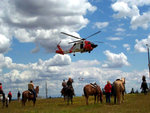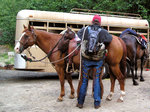

Practicing a methodical grid search across a hay field might not be how you imagine a day of horseback riding, but that is just one of the training activities which keeps the Clark County Mounted Search and Rescue team prepared to assist in emergencies.
For this training, bullet casings were scattered across a field and riders held their line of horses to a slow walk, shoulder to shoulder, to peer through every inch of the tall grass for their “clues.”
Riders learned different search patterns and when to use each one, and they learned to look at an area through the eyes of their team. For example, if a lead rider is watching the path ahead, riders who follow search each side of the path to cover a broader area. Riders learn to communicate with each other in the field, and to use two-way radios to stay connected with officers back at the search base.
Clark County Mounted Search and Rescue (CCMSAR) is a 16-member, all-volunteer group that works in coordination with the Clark County Sheriff’s Office and surrounding counties to locate and rescue missing persons.
Deputy Kevin Allais oversees the team’s training and membership to ensure that riders have required background checks and receive training for their duties. And since he is familiar with the mounted team, Allais can help officers identify those situations where mounted assistance will be useful.
Sgt. Fred Neiman, public information officer for the Clark County Sheriff’s Office, has worked with the Mounted Search and Rescue Team since its inception.
“They are a fabulous resource available to us to help with search missions,” Neiman said. He explained that CCMSAR is typically called out when searching trails or rural areas.
According to Dennis Benson, CCSAR team captain, a mounted search offers several advantages. A horse can cover much more distance than a person on foot, at a faster pace. They are quiet – other than the crunching of hooves – so searches can hear cries for help, and horses can navigate rugged areas that motorized vehicles could not traverse. A rider on horseback is higher and can see further, and horse’s keen senses will often alert their rider to a situation that people don’t notice.
CCMSAR was founded in 2004, when the Clark County Sheriff’s Office and the Fence Riders at the Clark County Fair began to talk about the possibility of a mounted search team. The Fence Riders embraced the new challenge and started training. According to Benson, there were no books or information available at that time, so they created their Standard Operating Procedures from scratch.
Washington state requires all members to have training in first aid, GPS, and survival skills. In addition, it was essential to have a learning guide for their equine partners. On a search, horses may face challenges that trigger their natural instinct to flee, and they are trained to remain calm and trust their handler in a wide variety of situations.
Not every horse is cut out for CCMSAR. They must have the endurance to traverse rough hilly country for a full day, and the ability to do their job in unpredictable situations. Training exercises expose mounts to baby strollers, ropes, balloons, people carrying backpacks, flares and water crossings, all potentially frightening to a horse.
Members meet twice per month for ongoing training in Core Competencies. Benson explained that by riding their horses together, they learn to know each one’s strengths and quirks. Some horses prefer to lead on the trail while others like to follow, each horse has a different “personal space,” and some horses become anxious when separated from their group.
The horses practice performing in every role, since they must be flexible in an emergency.
The Core Competencies start with the basics. A rider must catch their horse in an open arena and saddle him unassisted.
“Some people couldn’t saddle their own horse,” said Benson.
They might have ridden for years but a spouse or friend had always saddled their horse, so this was a new skill. Horses must learn to walk calmly into any size or shape of horse trailer, under any conditions, because riders may “horse pool” to sites with limited trailer parking.
Recently the group completed “helicopter training,” a four-hour class where riders learned safe practices (tip: do not walk into the operating rotors) and horses got to experience the potentially frightening equipment.
GPS technology has made searches more effective. Riders carry a GPS device with a two-way radio, which transmits their route to a base unit. This allows deputies to see, in real time, what areas have been covered by multiple searchers. Horses search separately from dogs, since horses introduce scents which could hinder a dog’s tracking.
It’s a big commitment to be a member of the CCMSAR team. Each rider has invested upwards of $10,000 in horses, equipment, trucks and trailers, said Benson. Members are prepared to respond to emergencies 24 hours a day, 365 days per year.
Riders have assisted in the search for a lost mushroom picker in the mountains, a child on the autism spectrum who was separated from his parents, and an elderly woman with memory loss who wandered away from her rural home.
The reward is in the challenge of learning and maintaining new skills, and coming to the aid of people in a crisis situation. And the best part, says Benson, is that equestrians can “give back” to their community with the help of their equine buddies.